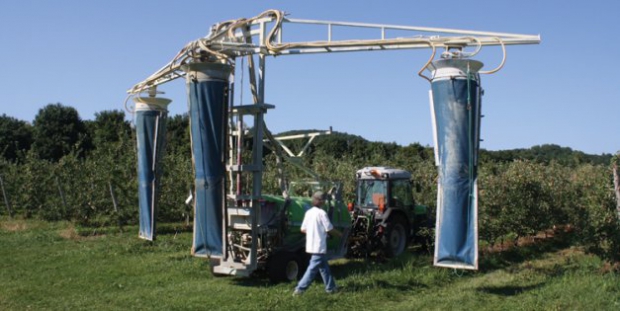
This sleeve sprayer was custom-built for Fruiteraie des Gadbois based on research findings by agricultural engineer Bernard Panneton. Fans on top push air down through the sleeves, pushing spray dispensed from nozzles mounted outside the sleeves. (Richard Lehnert/Good Fruit Grower)
Fruiteraie des Gadbois has another unique feature, a tower, or sleeve, sprayer Benoit Gadbois developed working with Dr. Bernard Panneton and Carl Bissaillon.
Benoit demonstrated it in the family’s orchards during the International Fruit Tree Association tour to the Quebec area last summer.
Panneton is an agricultural engineer at the horticultural research center in St-Jean-sur-Richelieu, and Bissaillon assembled the sprayer at Univerco, a Bissaillon family-owned company at Napierville, Quebec, that builds specialized machines for the produce industry.
The machine sprays both sides of three rows of trees. Three sleeves made of fabric are suspended from a boom over the tree tops. These sleeves deliver air from fans at the top, shooting air downward and diffusing it through the sleeve walls. It moves spray material from nozzles.
“The three-row tower sprayer evolved from our Récupair concept,” Penneton said. “One of the important features of the Récupair
Récupair also incorporated a spray recovery panel facing the boom on the opposite side of the trees, he said. It was supposed to function as a tunnel sprayer, recovering any excess spray material and recycling it.
“Field trials showed that spray recovery was achieved, but this was good mostly when the application volume was higher and early in the season. At lower application volumes in developed foliage, recovery was about 10 percent, less than expected,” Panneton said.
So for this sprayer, the idea of recovery panels was not implemented. “Recovery was not as good as expected, the sprayer would be more complicated, would cost more, and would be more difficult to move around,” he said. “We kept the idea of the vertical sleeves and adjusted the airflow according to our research findings.”
The ideas behind the sleeve sprayer are to reduce the amount of pesticide used by distributing it better and losing less to drift, and to save fuel by reducing the power needed to move air.
Panneton was one of several Canadian scientists to lose their positions in funding cuts this year. He will no longer be doing sprayer research, so this sprayer is an orphan—the only one of its kind unless some interested grower wants one built.
Tower sprayers and tunnel sprayers are being worked on in Europe.
——-
Editor’s note: The story headline was shortened on August 13, 2014, removing ‘one-of-a-kind.’

If you have a look on http://www.munckhof.org you will see that this sprayer is a copy from the Munckhof 3 row sprayer, developed by the Munckhof compagny in Holland, and not by mr. Paddeton. All he did was making a shameless copy. See also on the side all the other machines we are making as the pluk-o-track for harvesting apples and pears.
We have this sprayer in prodution and pattented for many years, and satisfied customers in the also in the U.S.A.
We expect an reaction from Mr. Bernhard Panneton.